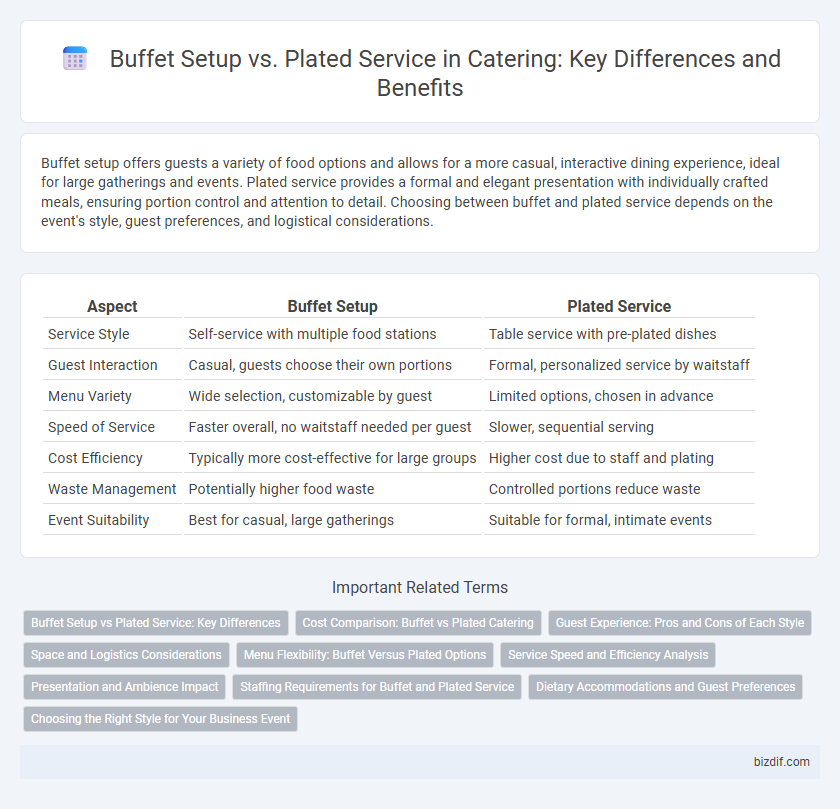Buffet setup offers guests a variety of food options and allows for a more casual, interactive dining experience, ideal for large gatherings and events. Plated service provides a formal and elegant presentation with individually crafted meals, ensuring portion control and attention to detail. Choosing between buffet and plated service depends on the event's style, guest preferences, and logistical considerations.
Table of Comparison
| Aspect | Buffet Setup | Plated Service |
|---|---|---|
| Service Style | Self-service with multiple food stations | Table service with pre-plated dishes |
| Guest Interaction | Casual, guests choose their own portions | Formal, personalized service by waitstaff |
| Menu Variety | Wide selection, customizable by guest | Limited options, chosen in advance |
| Speed of Service | Faster overall, no waitstaff needed per guest | Slower, sequential serving |
| Cost Efficiency | Typically more cost-effective for large groups | Higher cost due to staff and plating |
| Waste Management | Potentially higher food waste | Controlled portions reduce waste |
| Event Suitability | Best for casual, large gatherings | Suitable for formal, intimate events |
Buffet Setup vs Plated Service: Key Differences
Buffet setup offers guests a wide variety of food options allowing self-service and flexible portion control, ideal for casual or large events. Plated service provides a more formal dining experience with pre-portioned meals served directly to guests, ensuring consistent presentation and portion sizes. Choosing between buffet and plated service depends on factors like event style, guest interaction, and desired service efficiency.
Cost Comparison: Buffet vs Plated Catering
Buffet catering often reduces labor costs by requiring fewer servers, leading to lower overall expenses compared to plated service, which demands a higher staff-to-guest ratio for individual plate presentations. Food waste tends to be higher in buffet setups due to overproduction, potentially increasing food costs, whereas plated service allows precise portion control that minimizes excess. Venue rental fees may also vary as buffet setups require more space for food stations, impacting the total budget in ways that differ from the typically more compact plated dining arrangement.
Guest Experience: Pros and Cons of Each Style
Buffet setup offers guests variety and self-paced dining, fostering a social atmosphere but may lead to longer wait times and food temperature inconsistencies. Plated service provides a more formal, seamless experience with precise portion control and consistent presentation, enhancing guest comfort but limiting menu choices and interaction. Choosing between buffet and plated service directly impacts guest satisfaction based on event type, guest preferences, and desired service style.
Space and Logistics Considerations
Buffet setups require ample space to accommodate multiple stations and allow guests to serve themselves efficiently, reducing the need for extensive staff but demanding careful flow planning to prevent congestion. Plated service optimizes space by using seated arrangements, ideal for smaller venues or events prioritizing formal dining, yet demands more staff for timely food delivery and clearing. Effective logistics in buffet setups involve organizing stations for ease of access and replenishment, while plated services focus on synchronization between kitchen and wait staff to ensure seamless, timely service.
Menu Flexibility: Buffet Versus Plated Options
Buffet setups offer extensive menu flexibility, allowing guests to choose from a diverse selection of dishes tailored to various dietary preferences and restrictions. Plated service typically involves a fixed menu with limited customization, but ensures portion control and a cohesive dining experience. Buffets accommodate larger groups with varied tastes, while plated options prioritize presentation and timing consistency.
Service Speed and Efficiency Analysis
Buffet setup enables faster service speed by allowing guests to self-serve simultaneously, reducing wait times compared to plated service where each meal is individually prepared and served. Efficiency in buffets is heightened through streamlined food replenishment and reduced labor costs, while plated service demands more staff for meal distribution and precise timing. Analyzing service speed and efficiency reveals buffets optimize high-volume events with quick turnover, whereas plated service suits formal events prioritizing presentation and individualized attention.
Presentation and Ambience Impact
Buffet setups enhance presentation by offering visual variety and vibrant food displays that invite guest interaction, creating a lively and dynamic ambience. Plated service delivers a more refined and elegant presentation, emphasizing individual dish artistry and fostering an intimate dining atmosphere. Each setup influences the event's overall mood and guest experience, with buffets promoting social engagement and plated service ensuring personalized sophistication.
Staffing Requirements for Buffet and Plated Service
Buffet setups require fewer waitstaff since guests serve themselves, allowing for more flexible staffing and lower labor costs. Plated service demands a higher number of servers to ensure timely meal delivery and personalized attention, increasing labor expenses and coordination complexity. Efficient staffing allocation in each service type directly impacts guest experience and operational budgeting.
Dietary Accommodations and Guest Preferences
Buffet setup allows guests with various dietary accommodations to customize their meals, accommodating allergies, gluten-free, vegetarian, and vegan preferences more flexibly. Plated service offers precise control over portion size and presentation, ensuring consistent delivery of specific dietary requirements as requested. Both service styles cater to guest preferences, but buffets promote greater variety while plated service enhances personalized attention and formal dining experience.
Choosing the Right Style for Your Business Event
Buffet setup offers guests variety and flexibility, allowing them to sample multiple dishes and accommodate dietary preferences, making it ideal for casual or large-scale business events. Plated service provides a more formal dining experience with controlled portion sizes and elegant presentation, suited for corporate dinners or events where timing and service precision are priorities. Selecting between buffet and plated service should align with event goals, guest expectations, and logistical considerations to ensure optimal guest satisfaction and seamless execution.
buffet setup vs plated service Infographic

 bizdif.com
bizdif.com